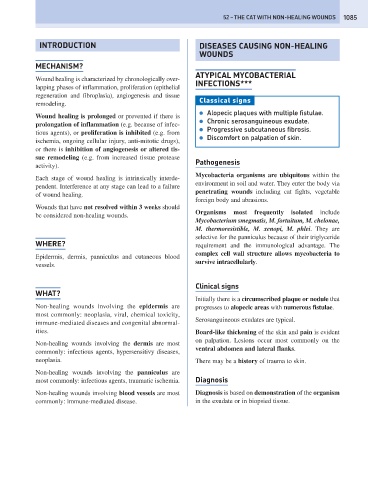Page 1093 - Problem-Based Feline Medicine
P. 1093
52 – THE CAT WITH NON-HEALING WOUNDS 1085
INTRODUCTION DISEASES CAUSING NON-HEALING
WOUNDS
MECHANISM?
ATYPICAL MYCOBACTERIAL
Wound healing is characterized by chronologically over- INFECTIONS***
lapping phases of inflammation, proliferation (epithelial
regeneration and fibroplasia), angiogenesis and tissue
Classical signs
remodeling.
● Alopecic plaques with multiple fistulae.
Wound healing is prolonged or prevented if there is
● Chronic serosanguineous exudate.
prolongation of inflammation (e.g. because of infec-
● Progressive subcutaneous fibrosis.
tious agents), or proliferation is inhibited (e.g. from
● Discomfort on palpation of skin.
ischemia, ongoing cellular injury, anti-mitotic drugs),
or there is inhibition of angiogenesis or altered tis-
sue remodeling (e.g. from increased tissue protease Pathogenesis
activity).
Mycobacteria organisms are ubiquitous within the
Each stage of wound healing is intrinsically interde-
environment in soil and water. They enter the body via
pendent. Interference at any stage can lead to a failure
penetrating wounds including cat fights, vegetable
of wound healing.
foreign body and abrasions.
Wounds that have not resolved within 3 weeks should
Organisms most frequently isolated include
be considered non-healing wounds.
Mycobacterium smegmatis, M. fortuitum, M. chelonae,
M. thermoresistible, M. xenopi, M. phlei. They are
selective for the panniculus because of their triglyceride
WHERE? requirement and the immunological advantage. The
complex cell wall structure allows mycobacteria to
Epidermis, dermis, panniculus and cutaneous blood
survive intracellularly.
vessels.
Clinical signs
WHAT?
Initially there is a circumscribed plaque or nodule that
Non-healing wounds involving the epidermis are progresses to alopecic areas with numerous fistulae.
most commonly: neoplasia, viral, chemical toxicity,
Serosanguineous exudates are typical.
immune-mediated diseases and congenital abnormal-
ities. Board-like thickening of the skin and pain is evident
on palpation. Lesions occur most commonly on the
Non-healing wounds involving the dermis are most
ventral abdomen and lateral flanks.
commonly: infectious agents, hypersensitivy diseases,
neoplasia. There may be a history of trauma to skin.
Non-healing wounds involving the panniculus are
most commonly: infectious agents, traumatic ischemia. Diagnosis
Non-healing wounds involving blood vessels are most Diagnosis is based on demonstration of the organism
commonly: immune-mediated disease. in the exudate or in biopsied tissue.

